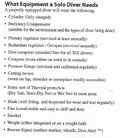I see, I do not think I had seriously considered just slinging a smaller sized bottle. That would definitely work, at least, for redundant air.
Another point I wanted to make but forgot to in my previous post is the problem that arises when "recreational" divers have such additional air. Now this may be a bit outside the scope of the discussion because it assumes that a rec diver with a pony will misuse it, but I will say it anyway as food for thought: recreational divers may be tempted to use their extra 4-11liters of air to get into some deco or deep trouble. I do not recall the exact logic or wording, but a short time ago a very salty old diver was telling me the story of why a standard bottle holds 11L. He explained, through some magic of numbers that went over my head, that the size of an 11L tank filled with air is generally too small to either be volume-effective at a depth great enough to pass NDLs. Whether or not his story is true is only partially relevant to my point that new divers with potentially twice as much air could more fesibly find themselves past NDLs if they were to use their tank as part of their gas supply.
I do not think it would be too far fetched to envision a diver justifying to themselves the use of an extra bottle and reg set that they schlepped around and paid for, despite their instructions saying it was for emergencies only. Again this all assumes a diver will misuse gear, which isn't necessarily a fair assumption. I am sure that currently quite a few divers utilize a pony for emergency redundancy, but I am not sure it would work so well for the general diving population. Remember that the general diving population has not taken it upon themselves to learn the intricacies of decompression theory, practice, or even remember from their classes why we have depth certifications beyond the "tank don't last as long when you are really deep" answer.






